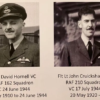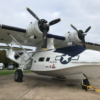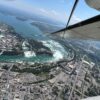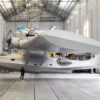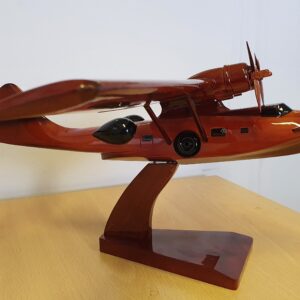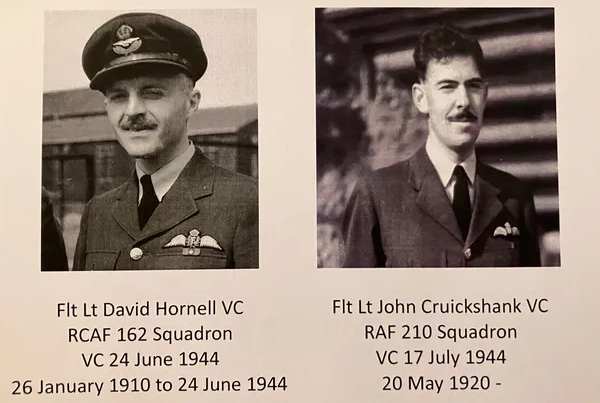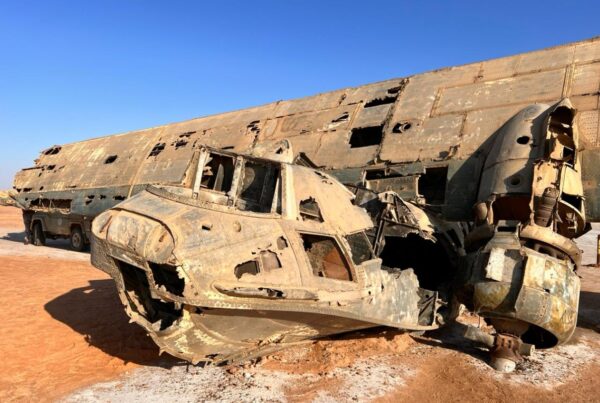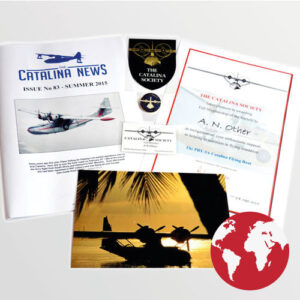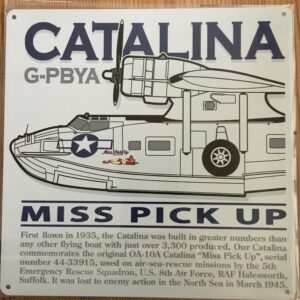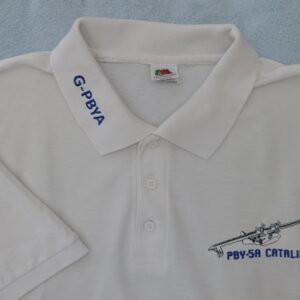Yet again I seem to have been able to produce an article full of news about surviving Catalinas and changes to that population – not bad for an aircraft whose remaining examples are all now in excess of 63 years old!
In Europe, the main news concerns the PBY-6A N285RA. I have reported on this aircraft on many occasions in the past and it will be familiar to many as the orange Catalina that was resident at both Biggin Hill and North Weald for many years. Acquired for the Israeli Defence Force Air Force (IDFAF) Museum with help from Boeing some time ago, a delivery flight from North Weald to Israel in May 2004 was thwarted by engine problems that necessitated a precautionary landing at Beauvais, north of Paris. Then, bad weather caused damage to the airframe and eventually the decision was taken to dismantle the PBY and deliver it by surface transport. Eventually, at the very end of February this year, the hull ofN285RA left Beauvais and it was seen on a massive low-loader at Antwerp on February 29th, awaiting transfer to a cargo ship. The remaining components will no doubt follow in due course. The hull at least is known to have subsequently arrived in Israel on May 11th. It is to be hoped that the future for this Cat’ is now looking rosier.

The hull of PBY-6A N285RA shown in Antwerp on route to Israel
via Ron Mak
Down under in Australia, there is still plenty to write about. PBY-6A VH-PBZ is being flown regularly with the Historic Aircraft Restoration Society (HARS) from Albion Park, Sydney. Some work has been carried out on the hull to facilitate the re-installation of blisters but temporary plating has been put in place to enable flights to continue until the project is completed. Meanwhile, the other Australian registered PBY-6A VH-CAT is still sitting at Seia in Portugal awaiting the acquisition of new engines following the failure of one unit just before the intended delivery flight from Europe to Australia. This potentially expensive exercise mans that the delivery is not likely to take place just yet unfortunately. Other Australian news concerns the unidentified PBY-5A(M) nose section that was acquired a few years ago by the Clyde North Aircraft Preservation Group (CNPAG) at Wagga Wagga. More recently, it was displayed for a while at the Fleet Air Arm Museum at Nowra but during the latter half of 2007 it was moved again, this time to the HARS Museum at Albion Park where it is on display inside the museum buildings.

The forward hull of a former RAAF PBY-5A(M) now on display at Albion Park, Sydney, New South Wales
Photo: Lawrence Acket
In the USA, the former Confederate/Commemorative Air Force PBY-5A N68756, currently stored on a farm in Midland Texas after being saved from the scrapman, has been found a new home – in Australia! It will be shipped to its as yet un-named new owner in the next few months apparently.
VH-BDP was a wartime Royal Australian Air Force Catalina flying boat (as opposed to amphibian) that was sold as surplus post-war and then used for a while to transport shellfish between Tasmania and the Australian mainland. Later, it was sold to one Richard Cobley and used in the Republic of Indonesia as RI-005 for various nefarious activities including gun and rug running before it was all but destroyed in a single-engined take off accident from a river at Djambi. A few years ago, the remains were salvaged but deemed too far gone for restoration. Amazingly, local engineers have constructed a full-size replica of the original Catalina and this is now on display at a museum in what is now known as Jambi. The replica carries the dual markings VH-BDP/RI-005. More on this remarkable project in a future issue of The Catalina News.
In Canada, several Catalinas/Cansos have been in the news in recent months. At Nanaimo, the increasingly neglected Canso A C-FNJB, one-time sister aircraft to our own C-FNJF/G-PBYA, has been the subject of interest from two or three Canadian preservation groups with plans varying from realistic to hugely optimistic. It is hoped that it can be acquired and restored by one of these groups very soon in order to arrest its decline. Another former Canso A in the same registration sequence, C-FNJE, has been languishing on the shore of Sitidgi Lake near Inuvik, North West Territories since it sank in a water pick-up accident on July 24th, 2001. Again the subject of interest from preservation groups, salvage has been made difficult by the remoteness of the site and the interest of local residents claiming land rights that made recovery a problem. However, the substantially complete and relatively undamaged airframe has recently been acquired by an enterprising individual and it was dismantled on site and trucked out to Inuvik during April. More news when we have it!
Two of the former Newfoundland Provincial Government water bomber Cansos have been moved recently following their retirement a few years ago and subsequent storage at Gander. C-FNJC is now in storage in one of goose bay’s hangars awaiting delivery to the town of Stephenville where it will be preserved in static condition. Meanwhile, C-FIZU, originally built as a US Navy PBY-6A, was flown from Gander to a water landing and future preservation at the township of St Anthony in Newfoundland a few months ago.
Miami-based Cyclone-powered Super Cat N287 owned by Charlie Clements has been for sale for sometime although, in the absence of a buyer, he has been flying it regularly. Rumours of a sale to both South Africa and South America were apparently incorrect and it has now been sold – in Borneo! Charlie has advised us that on January 31st this year, the PBY was taken out into ‘international waters’ and the sale to a US-based company was completed. Work is now underway to prepare N287 for the long delivery flight, initially to Singapore. It is intended that it will be fitted with blisters like the single-piece units o our won G-PBYA, new avionics, a lavatory compartment and a small galley. It will also receive selective landing gear valves for better water handling amongst other mods. It is possible that when delivery eventually takes place, N287 may come through Europe, an exciting prospect.
Many of the world’s surviving Catalinas, whether airworthy or not, owe their continued existence to their post-war conversion to water bombers for the forest fire fighting industry. Indeed, our own Duxford-based G-PBYA is one of them. Now, in 2008, there are a small number of Catalinas/Cansos still equipped with internal tankage but none are currently in use. With the withdrawal from active fire fighting of PBY-6A N85U, it does now seem quite possible that the long era of Catalina water bombers may have come to an end. N85U is a Wright Cyclone-powered Super Cat and has been engaged in saving forests in the north-west corner of the USA for many years, initially as a DDT ‘sprayer’ against infestations and then, from 1960 as a water bomber. It had a succession of operators in the USA and Canada until eventually it ended up with Flying Fireman Inc at Deer Park, Washington State in 1986. Since then it has seen frequent use over the years and as recently as 2007 flew ‘in action’ against no less than 35 fires on 32 active days between early-July and mid-October. Recently, however, officialdom decreed that no new contracts would be issued for this venerable PBY and so unless other, smaller hirers can be found it appears that its fire-fighting days are over.

A lovely shot of PBY-6A N85U approaching for a water pick-up before its recent retirement.
Finally, an item that does not relate to a specific Catalina ‘survivor’ but to an event that is taking place this year that commemorates the use of flying boats ‘down-under’. We have been advised by Melissa Nash, Marketing Assistant at the Historic Houses Trust of New South Wales that the Museum of Sydney is to hold an exhibition entitled ‘Flying Boats’ – Sydney’s golden age of aviation. Melissa tells us that: “1938 saw the dawn of a golden age of aviation when Rose Bay became home to Sydney’s first international airport, servicing the mighty flying boats – large and luxurious aircraft that alighted on water. This was an era when air travel was new, exciting and glamorous. Passengers traveling from Sydney to England enjoyed a leisurely ten-day trip in first class comfort with over 30 exotic stopovers. Flying boats played a vital role in World War II, and after the war they opened up the South Pacific as a holiday playground for Australians. As a result Sydney operated the world’s last major flying boat base until 1974. Featuring photographs, posters, film, models, a recreated cabin, a flying boat engine and fascinating personal stories, Flying Boats presents a definitive account of this extraordinary chapter in Sydney’s history.” This exhibition is being held between May 10th and September 14th – perhaps if any reader is fortunate enough to attend they can let us have a report!

Rose Bay was used by Catalinas during and after World War Two. Here, P G Taylor’s PB2B-2 Catalina VH-ASA Frigate Bird gets airborne from the bay with the flying boat hangars and the vertical tail of another PB2B-2 visible in the background.

Qantas Empire Airways used Rose Bay for its Catalina services out of Sydney and their PB2B-2 VH-EAW is seen here in a basic QEA livery. It was lost at Rose Bay in August 1949 when it was blown up and sunk by a saboteur.
Previous Comments:
Dee Kerwin – 9 August, 2009
Looking for Info on the Royal AirforceSquadron 262 They established a base on the Bot River Lagoon in Fisherhaven South Africa during World War 11



